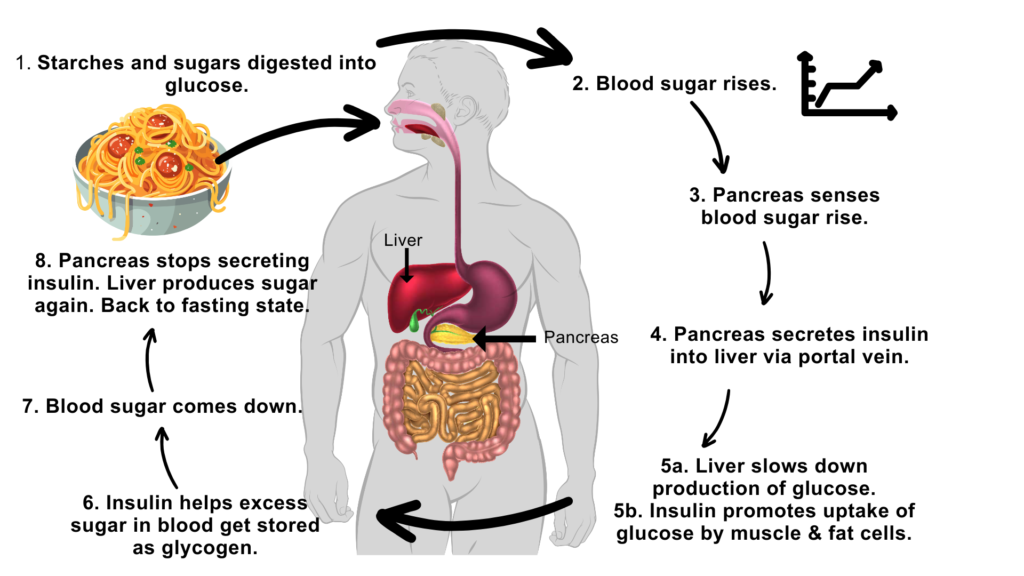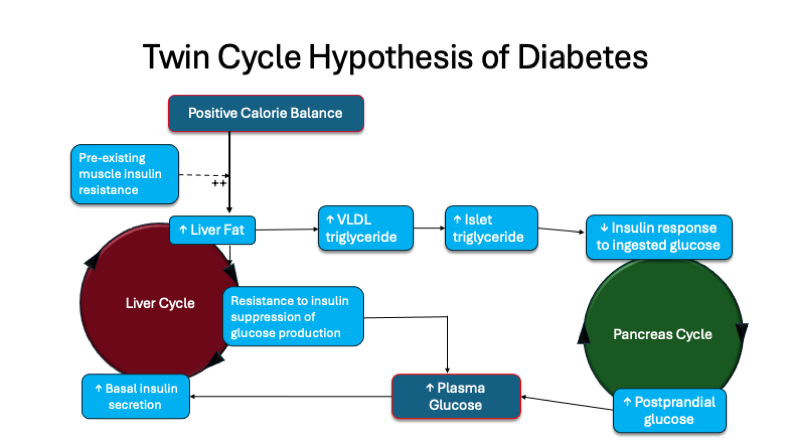
Overcome Fear of Diabetes. See How to Reverse Diabetes Now.
We need to understand what diabetes really is not just by symptoms. Only then can we help people deal with root causes and overcome fear of diabetes. There is a lot of confusion as to what is really the root cause of diabetes. Many people blame sugar as the culprit. Some people blame animal fats. But these are only part of the problem. The root cause is deeper, and simpler at the same time.
When you understand the root cause of diabetes you will no longer be afraid of it and you can take action to reverse your diabetes now.
Understand Diabetes’ Root Cause to Overcome Fear of Diabetes
Diabetes is excess fat in the liver and pancreas, which interfering with normal insulin production in the pancreas and a normal glucose response to food and meals. Professor Roy Taylor has the best explanation and best results for reversing diabetes. He says a person needs to lose about 30 to 35 pounds and keep it off to reverse diabetes by lowering fat content in the liver and pancreas. Liver fat is more easily modified and removed than pancreatic fat. Removing liver fat improves fasting blood glucose levels quickly. But insulin response to a glucose load isn’t normalized until the pancreas also becomes healthy with less fat.
What About Thin People Who Get Diabetes? And Fat People Who Don’t Have Diabetes?
Great questions! What if a person gets diabetes and isn’t excessively large or overweight? In this case it is still an accumulation of fat in the liver and pancreas.
You are just too fat for you.
Not every person can handle the same amount of fat in their body without causing diabetes. You still must lose the weight so your liver and pancreas are fit and healthy.
Some people have a higher propensity to accumulate fat in the liver and pancreas. This is why not every obese person has diabetes, though it is a risk factor.
This is also why people who are not overweight can also get diabetes. They are just too fat for their own body.
Professor Roy Taylor referred to this as a “personal fat threshold.”
How Does the Body Normally Deal with Glucose and Carbohydrates?

Under healthy conditions when you eat sugars and starches they are digested into glucose. This causes a rise in blood sugar, which is immediately detected by the pancreas.
In response to the elevating blood sugar the pancreas secretes insulin into the liver via the portal vein. The purpose of this insulin signal is to slow down the production of glucose by the liver, since there is a load coming into the body. A healthy liver responds immediately to the insulin signal from the pancreas and decreases glucose production.
Insulin also signals the rest of the body to store up energy. Muscle and fat cells are promoted to uptake more sugar and amino acids and fat from the bloodstream. It is feeding time.
Gradually the blood sugar comes down because of the lower glucose production by the liver and stowing away of glucose as glycogen in the liver and muscles. The pancreas then stops secreting insulin and the liver once begins metering out glucose to maintain all those tissues that rely heavily on glucose for their principle source of energy in their fasting state.
And then the cycle repeats next time carbohydrates are eaten.
How Does Diabetes Happen?

First, there is a calorie surplus. Some glucose is stored as glycogen, but fat is the most efficient method of storing extra energy in the body.
Excess fat in liver causes it to become resistant to insulin signal from the pancreas. Liver insulin resistance causes the pancreas to secrete more insulin to maintain healthy levels of blood glucose. This is very early in the disease process.
Liver increases its output of fat to the rest of the body for storage. First under the skin. Then around the organs. Also inside the muscles.
Tissues, like muscles, signal that they don’t want or can’t store more fat without compromising their function. This is called “insulin resistance.”
When the pancreas gets too much fat in it, the beta cells stop producing insulin. These cells de-differentiate in order to survive. This is the point of pancreatic exhaustion. Very high blood glucose levels result.
This is when uncontrolled diabetes is diagnosed, usually after years of the body dealing with excess calories. Understanding this process will help you overcome the fear of diabetes take action.
How Can You Reverse Diabetes?
The “Excess Calories” root cause must be reversed.
Weight loss must occur so that excess fat in the liver and pancreas are also removed. Research by Professor Roy Taylor and his team found that about 35 pounds of weight loss were required to reverse diabetes. In people who are near “normal” BMI (body mass index) about a 10% body weight loss instead of 35 pounds is needed to reverse diabetes.
The liver responds quickly to weight loss and helps restore fasting blood sugar levels to near normal within a few days or a week.
The pancreas takes several weeks during weight loss to restore its function. When working correctly the pancreas will prevent high blood sugar response to a glucose load from a meal.
Quite simply, you reverse diabetes by losing a significant amount of body weight.
Weight Loss is the KEY to Reversing Diabetes
Now that you know exactly what you need to do, you can make an action plan to reverse your diabetes. You have overcome fear of diabetes. You can reverse diabetes by losing a significant amount of weight.
Where to Find out More
Dr. Roy Taylor’s 25+ years of work on understanding and reversing diabetes can be found here:
https://www.ncl.ac.uk/magres/research/diabetes/reversal/#publicinformation

Here is the short book “Your Simple Guide to Reversing Type 2 Diabetes” by Professor Roy Taylor that explains his plan to reverse diabetes. The key is significant weight loss of about 35 pounds, or 10% of your body weight if you are near normal body weight.
Scientific References
1. Taylor R (2008) Pathogenesis of type 2 diabetes: tracing the reverse route from cure to cause. Diabetologia 51:1781–1789. doi: 10.1007/s00125-008-1116-7
2. Lim EL, Hollingsworth KG, Aribisala BS, Chen MJ, Mathers JC, Taylor R (2011) Reversal of type 2 diabetes: normalisation of beta cell function in association with decreased pancreas and liver triacylglycerol. Diabetologia 54:2506–2514. doi: 10.1007/s00125-011-2204-7
3. Steven S, Lim EL, Taylor R (2013) Population response to information on reversibility of Type 2 diabetes. Diabet Med 30:e135-138. doi: 10.1111/dme.12116
4. Taylor R (2013) Type 2 Diabetes: Etiology and reversibility. Diabetes Care 36:1047–1055. doi: 10.2337/dc12-1805
5. Steven S, Taylor R (2015) Restoring normoglycaemia by use of a very low calorie diet in long- and short-duration Type 2 diabetes. Diabet Med 32:1149–1155. doi: 10.1111/dme.12722
6. Taylor R, Holman RR (2015) Normal weight individuals who develop Type 2 diabetes: the personal fat threshold. Clin Sci (Lond) 128:405–410. doi: 10.1042/CS20140553
7. Steven S, Hollingsworth KG, Al-Mrabeh A, Avery L, Aribisala B, Caslake M, et al (2016) Very Low-Calorie Diet and 6 Months of Weight Stability in Type 2 Diabetes: Pathophysiological Changes in Responders and Nonresponders. Diabetes Care 39:808–815. doi: 10.2337/dc15-1942
8. Lean ME, Leslie WS, Barnes AC, Brosnahan N, Thom G, McCombie L, et al (2018) Primary care-led weight management for remission of type 2 diabetes (DiRECT): an open-label, cluster-randomised trial. Lancet 391:541–551. doi: 10.1016/S0140-6736(17)33102-1
9. Taylor R, Al-Mrabeh A, Zhyzhneuskaya S, Peters C, Barnes AC, Aribisala BS, et al (2018) Remission of Human Type 2 Diabetes Requires Decrease in Liver and Pancreas Fat Content but Is Dependent upon Capacity for β Cell Recovery. Cell Metab 28:547-556.e3. doi: 10.1016/j.cmet.2018.07.003
10. Taylor R, Leslie WS, Barnes AC, Brosnahan N, Thom G, McCombie L, et al (2018) Clinical and metabolic features of the randomised controlled Diabetes Remission Clinical Trial (DiRECT) cohort. Diabetologia 61:589–598. doi: 10.1007/s00125-017-4503-0
11. Lean MEJ, Leslie WS, Barnes AC, Brosnahan N, Thom G, McCombie L, et al (2019) Durability of a primary care-led weight-management intervention for remission of type 2 diabetes: 2-year results of the DiRECT open-label, cluster-randomised trial. Lancet Diabetes Endocrinol 7:344–355. doi: 10.1016/S2213-8587(19)30068-3
12. Taylor R, Barnes AC (2019) Can type 2 diabetes be reversed and how can this best be achieved? James Lind Alliance research priority number one. Diabet Med 36:308–315. doi: 10.1111/dme.13851
13. Taylor R (2019) Calorie restriction for long-term remission of type 2 diabetes. Clin Med (Lond) 19:37–42. doi: 10.7861/clinmedicine.19-1-37
14. Taylor R, Al-Mrabeh A, Sattar N (2019) Understanding the mechanisms of reversal of type 2 diabetes. Lancet Diabetes Endocrinol 7:726–736. doi: 10.1016/S2213-8587(19)30076-2
15. Xin Y, Davies A, McCombie L, Briggs A, Messow C-M, Grieve E, et al (2019) Within-trial cost and 1-year cost-effectiveness of the DiRECT/Counterweight-Plus weight management programme to achieve remission of type 2 diabetes. Lancet Diabetes Endocrinol 7:169–172. doi: 10.1016/S2213-8587(18)30346-2